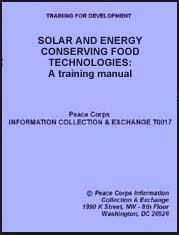
Solar and Energy Conserving Food Technologies
- (Peace Corps, 1984, 175 p.)
The use of dried foods
OVERVIEW AND GOALS:
Dried foods retain a surprising amount of their original flavor and aroma. Both are, in fact, often enhanced because of the concentrated nature of dehydrated food. Used either in the dried state or after rehydration, these foods can provide a delicious and nutritional addition to one's diet. In this session, participants learn specific ways using dried foods.
OBJECTIVES:
To examine the various uses of dehydrated foods
To learn how to rehydrate as well as cook with dried foods
RESOURCES:
Preserving Food by Drying
Putting Food By, Chapter 21
HANDOUTS:
"Rehydration and Cooking of Dried Food", Handout 18A
MATERIALS:
Variety of dried foods
Water (for rehydrating)
Several shallow bowls
PROCEDURES AND ACTIVITIES:
1. (10 minutes) Introduction
Ask particpants what dehydrated foods they have either eaten in the dried state or used in cooking. What was their opinion of the taste? The color, texture and aroma? Other reactions or comments?
2. (35 minutes) Uses of Dried Foods
Distribute "Rehydration and Cooking of Dried Foods", Handout 18A. Review the suggestions for use in cooking. Have participants suggest examples of local dishes that could be made using dehydrated foods.
Review different methods of rehydrating. Demonstrate as each method is discussed.
Pass around several dishes of rehydrating foods, including a mixture of vegetables with a strong aroma so people can observe the retention of aroma as well as the proper amount of water to use in proportion to the food.
3. (15 minutes) Summary
Discuss any further questions participants may have regarding the use of dried foods. Explain that part of the construction period from now on should be used as a time to experiment with the cooking of dried foods.
TRAINER'S NOTE
It may be helpful to post a sign-up list, with time slots available for cooking, to avoid overcrowding of the facilities. Remember to give a kitchen tour before groups start to use the area. For the practice in using dried foods the participants should submit a list of ingredients needed the day before they plan to cook. Encourage people to use local recipes, as well as to use their Fireless Cookers during the preparation of food.
REHYDRATING AND COOKING DRIED FOODS
In general, most dried foods can be successfully rehydrated, by allowing them to soak up the original amount of moisture lost, and then cooking them as you normally would. Many foods can be simply rehydrated and eaten without being cooked. The majority of dried foods are delicious just as they are; it is really a matter of individual taste.
Experiment by using dried foods in a variety of ways to decide what your own preferences are. The following are some suggestions for cooking with dried foods in the form of powder, leather, slices or strips.
Powdered Foods
Vegetables: broth, sauces, baby food Fruits: drinks, puddings, dessert flavoring, baby food Herbs: any recipe where fresh herbs are used
Leather
Vegetables: soup, sauces, stews Fruits: drinks, pies
Slices or Strips
All foods dried in this form can be rehydrated and then used in cooking as if they were fresh.
How to Rehydrate
All foods to be used in cooking (except for leafy greens, herbs, and foods in powdered form) should be rehydrated first to avoid a tough or rubbery texture.
NOTE: Dried foods rehydrate to approximately 90% of their original size.
Use one of the following two methods for rehydrating foods, whether they will then be cooked or not. The slow method should be used if time allows as it results in a better texture.
Slow Method
Place dried food in a bowl and barely cover with cold water. Soak for 2-6 hours until the required texture is attained.. (Refrigerate if soaking for more than 2 hours).
Quick Method
Place dried food in a sauce pan and barely cover with cold water. Bring to a boil, and then simmer until the food is nearly restored to its original texture.
Nate: Foods soaked for too long or in too much water become soggy and waterlogged. It is better to start with too little water and add more later as it becomes necessary during the rehydration process.